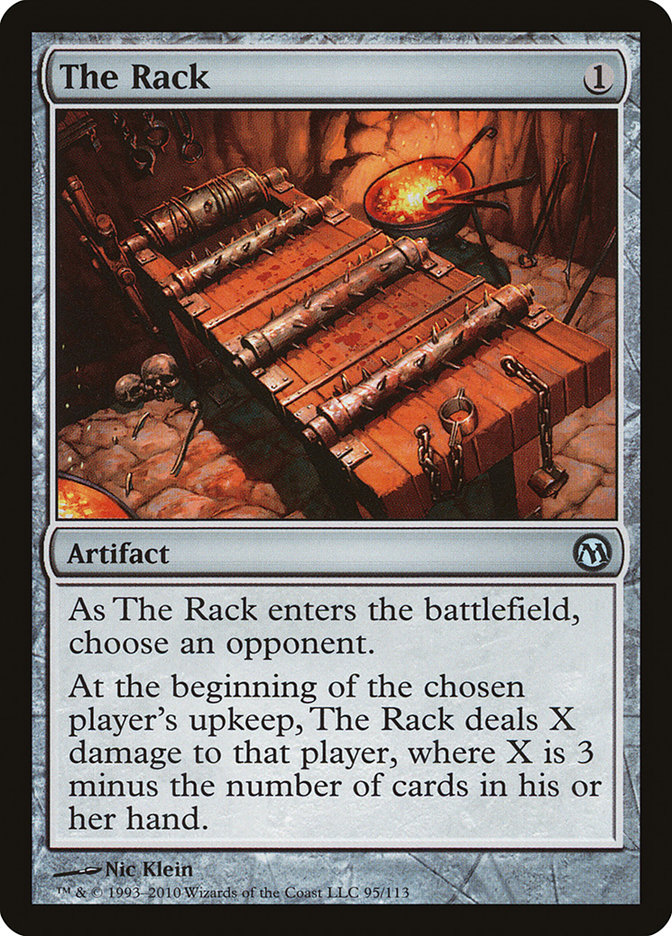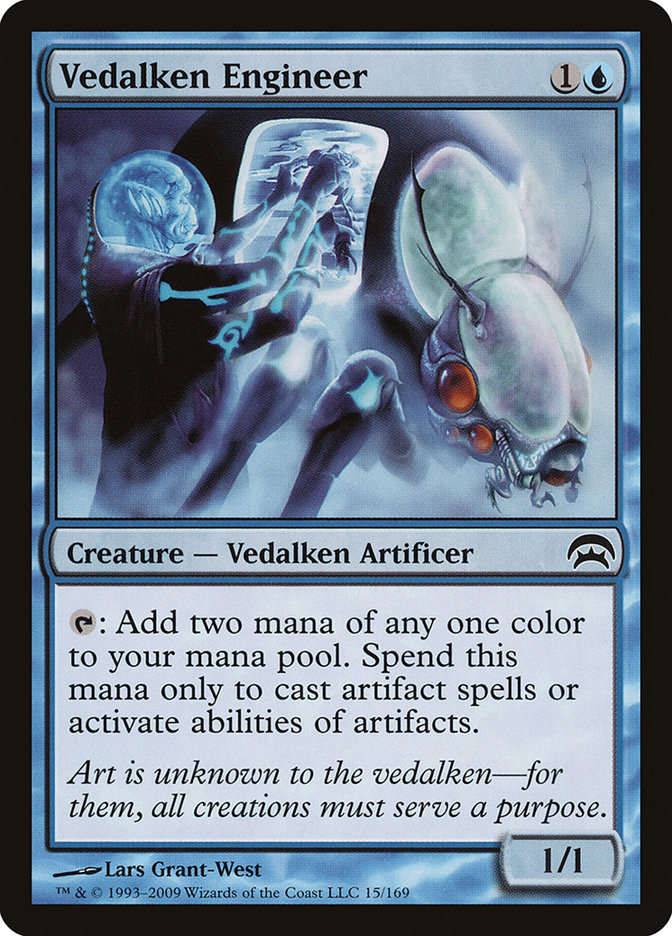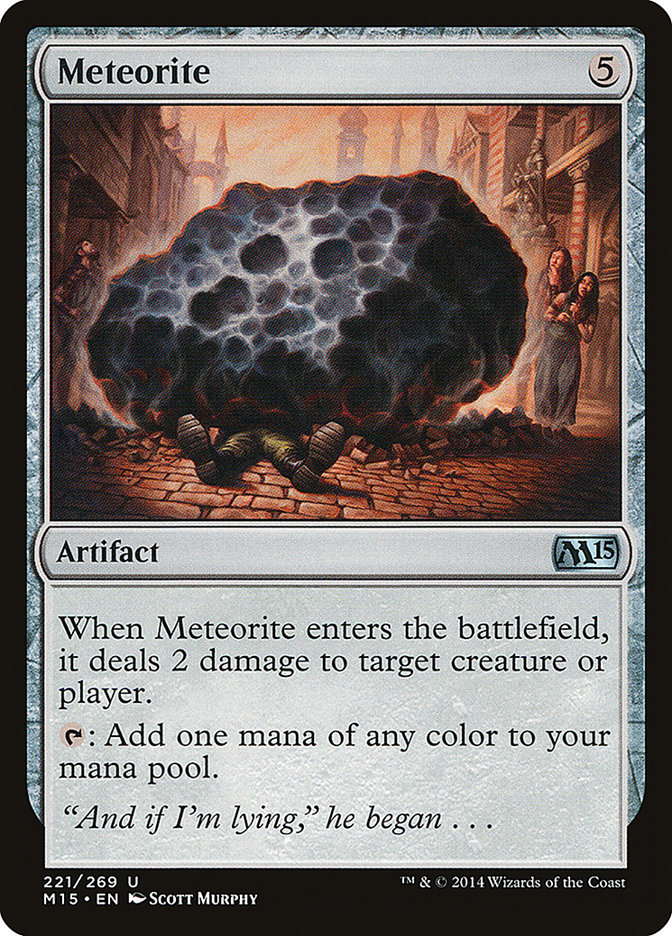What is it about artifacts that I love so much?
Let me count the ways…
When I saw my friend’s Myr deck in college, complete with classics like Myr Enforcer, the
better
original art for Gold Myr, and Mycosynth Golem, I was sold. The idea of machines and historical relics ruling the world was too much for my
ninteen-year-old mind, and I couldn’t wait to build a deck of my own, complete with artifact-based accelerants and high-cost game-enders.
That love hasn’t died; my non-colored Kozilek the Butcher Commander deck is one of my personal favorites, and colorless cards in general tend to be my
favorite to collect and showcase. Even colorless Pokemon have always been my favorite too; the fact that they do not conform to a color’s identity, in a
sense, gives them their own unique flavor and feel.
Despite my devotion to colorless, other colors have lent their card slots to augment the power of the brown.
Blue is by far the most frequent contributor to the artifact cause, granting complementary abilities and spells to reward the metal-minded mage. Vedalken
Engineer is one of the stronger and more memorable examples. Lucky for us, this old effect is exactly what the doctor ordered. Or, in this case, the
artificer ordered.
The spiritual successor of Vedalken Engineer, Renowned Weaponsmith sacrifices colored mana production for extra toughness, an (unfortunately) more relevant
creature type, and a narrow but potentially awesome activated ability, depending on what the Vial of Dragonfire does out of the next set. Its Standard
counterpart, Chief Engineer, can’t actually compare with the quality of this card. First, it effectively does what Chief Engineer and one other creature do
as far as producing mana, and it can be used to activate abilities of artifacts too, something Chief Engineer only dreams about. This is some of the most
objectively powerful standalone acceleration in Standard so long as you have the targets for it to feed. Heaven knows there are several that pop to mind,
the most likely being Scuttling Doom Engine and Soul of New Phyrexia. But I have to be honest, the first card I thought of was Meteorite.
Yes, this card, which I like to call “the Shock Rock,” jumped to mind first. With an on-time Weaponsmith, you can power out a turn-3 Meteorite, which helps
advance your board while potentially killing an opposing aggro threat or dealing some incidental damage to your opponent. The following turn, because
you’ve spent permanent mana, you will then be ready to cast either of the six-drops I mentioned earlier. The damage is what sold me; playing mana rocks is
often an investment as opposed to an interactively minded play. Unlike in Chief Engineer World, you can hit this on-curve, and I think that’s enough for us
to get started.
The ramp targets are still the best I could think of, so with a bit of fleshing out, I decided to build a blue-focused artifact ramp list. A la Evan Erwin,
let’s go!
Creatures (18)
Planeswalkers (2)
Lands (24)
Spells (16)
Sideboard

Creatures
While I believe that Renowned Weaponsmith is superior to Chief Engineer in almost every way in Standard, it is still a reasonable card by itself. It helps
me bridge the two-to-four-mana gap, and in the era of aggressive two-power creatures, a strictly better Lumengrid Warden is pretty exciting. Thus, they are
used in tandem. Aww, best friends!
Scuttling Doom Engine, as opposed to the arguably more powerful Soul of New Phyrexia, is my choice for this pile of metal. It requires no additional mana
commitment to reach its full potential, and the fact that it can’t be blocked by low-power creatures also means that low-toughness creatures will
frequently also be excluded from the blocking order, giving you effective trample. The sooner you can get the Engine running, the more terrifying it is.
From there, we move to the Alpha original, Juggernaut. Five power for four is always a good rate, and although we got another efficient beater in Ugin’s
Construct, Juggernaut’s attack-every-turn clause is vastly superior to the one-for-two clause on the Construct. Juggernaut can attack into and kill the
vast majority of today’s creatures. Five power is a lot, and both ramp creatures can get you into the Juggernaut on turn 3. You can even tap it down with
Chief Engineer to preserve it for a more opportune turn to cast any number of artifacts the deck supports. That being said, don’t be afraid to trade it off
as an efficient defender. Despite today’s formats being filled with Lightning Strike and Bile Blight, Juggernaut is still a hard hitter.
Spells
Okay, so let’s start with Meteorite and the beef I have with it. And that beef is flavor (haha).
Let’s look at Meteorite. So some poor unsuspecting creature gets smashed in the head with a space rock. This rock deals two damage. However, getting struck
by lightning, or more specifically a Lightning Bolt, deals three damage. Lightning strikes are not always deadly or destructive. In fact, many people live
to tell the tale of being struck by lightning. I’m pretty sure this guy wouldn’t have survived
seven meteorite strikes. I know, I know, it was proabably for balance reasons. But two damage? C’mon. The typical mana artifact costs three and provides one, and for two
colorless mana you can add a Shock to it. Thanks to the artifact ramp, this is much easier, and it helps you ramp even faster.
A set of ol’ faithful Divination represents the only spell-based playset in the deck. With turn 2 occupied by playing an Artificer, turn 3 should either be
a cool artifact or a Divination. The deck is constructed in such a way that doing both comprise the typical turn routine. Travelers’ Amulet is a weird one.
However, look at two things. First, Renowned Weaponsmith can tap alone and recover your land from the deck; no more waiting a turn or throwing off your
tempo to make sure your hand is stocked with land. Getting land drops is important despite the mana creatures featured here; there are lots of empty boards
where resolving a six-drop without help will be all a player can do to stay alive and/or apply pressure. Second, it’s a more convenient way to do Evolving
Wilds, providing an easy delve target.
The deck lacks lots of ways to protect itself or exert removal on an opponent. However, Aetherspouts, powered by Meteorite and consistent land drops, can
shut down any offense in a heartbeat, giving you the time you need to untap and play your biggest threats. It’s a bit expensive, but its power to stall or
even stop the game is exciting enough to merit it, with an extra two copies coming in from the sideboard. Monastery Siege helps filter away too many mana
creatures or big bulky dudes, and it gives your huge game-finishers a bit of protection. They’ll feel like rock stars with a blue enchantment bodyguard.
Finally, two Dig Through Time let you spend all those Traveler’s Amulets and dead Juggernauts to find any creature or the venerable Ugin, the Spirit
Dragon. You can be sure you’ll have the basics to cast it the moment you find it.
Land
The Island count must remain high, given all the basic land searching this deck requires. Otherwise, your set of obligatory Flooded Strands and Polluted
Deltas might be visible here to fuel the delve engine. I’m still a fan of eight Temples, and I have yet to be wrong about it. With so few turn 1 plays,
you’re not giving up much, and you always want to maintain the balance between producers and smashers.
The Sideboard
The sideboard is a bit of a hodge-podge. Against planeswalker and tricky creature decks, Phyrexian Revoker makes an excellent choice. Given its low cost,
it can be cast off one Renowned Weaponsmith alone, and even besides that, it can be used in multiples with Chief Engineer to get those big creatures out
sooner. Negate is still powerful, and I love Perilous Vault. With three lands and one Renowned Weaponsmith, you can wipe the face of the earth clan quickly
and with minimal damage to your own resources. I did include a couple Soul of New Phyrexia just to try them out, and finally, one extra Dig Through Time
would help me stay frosty against answer-everything control decks, which seem to be growing in popularity at my shop. Also, I added and eventually culled
down to a single copy of Colossus of Akros. For decks that can’t kill this in response, this is a straight-up game-winner. Particularly helpful for linear
removal strategies, most decks can’t actually beat a 20/20 indestructible trampling creature. At least, that’s true the last time I checked.
In practice, this deck was a bit hit-or-miss. It folded to most aggro decks, but was actually very strong against midrange. A non-Abzan opponent hates
Scuttling Doom Engine, and even most G/B decks don’t have a good way to kill or block it effectively. I cast it with lands about 40% of the time, but I
never got it out on the four-turn clock. It was still pretty slow, and I had to block and lose Burnished Harts more frequently than I’d like. Divination
was great, as was Aetherspouts. It’s possible that I’d even include one more; these days, there aren’t many decks where Aetherspouts is truly worthless. In
short, I needed time to develop my board to a place I liked. I was soft to removal-heavy decks and aggro decks. As that represents a large constituency of
decks these days, it seems only fair that we play to that fact.
While blue is frequently associated with artifacts, cards like Shrapnel Blast; Bosh, Iron Golem; and Kuldotha Rebirth hint at red artifact synergies.
Combining the ramp and manipulation of blue with the potency and heat of red, we might be able to withstand the onslaught long enough to live the dream and
do seventeen in one turn with a Blasted Scuttling Doom Engine post-combat.
Let’s suit up!
Creatures (11)
Lands (24)
Spells (25)

Look at the fun ones in here! The creature crew has been brought down to the essentials. After trying deck number one, three Doom Engines felt fine, as
having two of those in your opening hand one too many times stuck with me. Instead, you infuse the deck with well-known burn spells like Lightning Strike
and Shrapnel Blast. Other fun burn spells, namely Goblin Boom Keg, do much the same thing. Bear in mind that, for both Meteorite and Goblin Boom Keg, the
damage can’t be prevented by protection, as these cards have no color against which a Gods Willing or Feat of Resistance might protect. The Amulet is more
valuable now that we’re two colors, and Tormenting Voice and Dig Through Time helps keep the right cards and burn spells in my hand at all times. The
sideboard reflects a potential to shift with such artifact-friendly favorites as Perilous Vault and Phyrexian Revoker as well as a suite of more typical
U/R control fare.
I wasn’t able to test either deck extensively, but this one was by far more fun. Shrapnel Blast, supported by cheap artifacts and draw spells, actually
felt alright. Adding something as simple of Lightning Strike made many bad hands keepable, and Dig Through Time was frequently cast for nearly full cost
without a problem. However, control decks still seemed to be a problem, as they could outpace me with stuff as simple as Radiant Fountain and tapped
Refuge-style lands. Post board, Nyx-Fleece Ram was nearly impenetrable.
So in the end, neither deck was outstanding, but they were both fun and had potential to be better. As the next couple sets come up, the base will be
better laid for more powerful and exciting artifact decks. Ensoul Artifact has been enticing me for months, and I have extensively playtested an
ever-evolving deck that features it. In fact, I’ve been actively working on it since September, but I’m not ready to reveal it to the world yet.
Did any of these artifact decks resemble your own brewing? Where has the Weaponsmith taken you?






